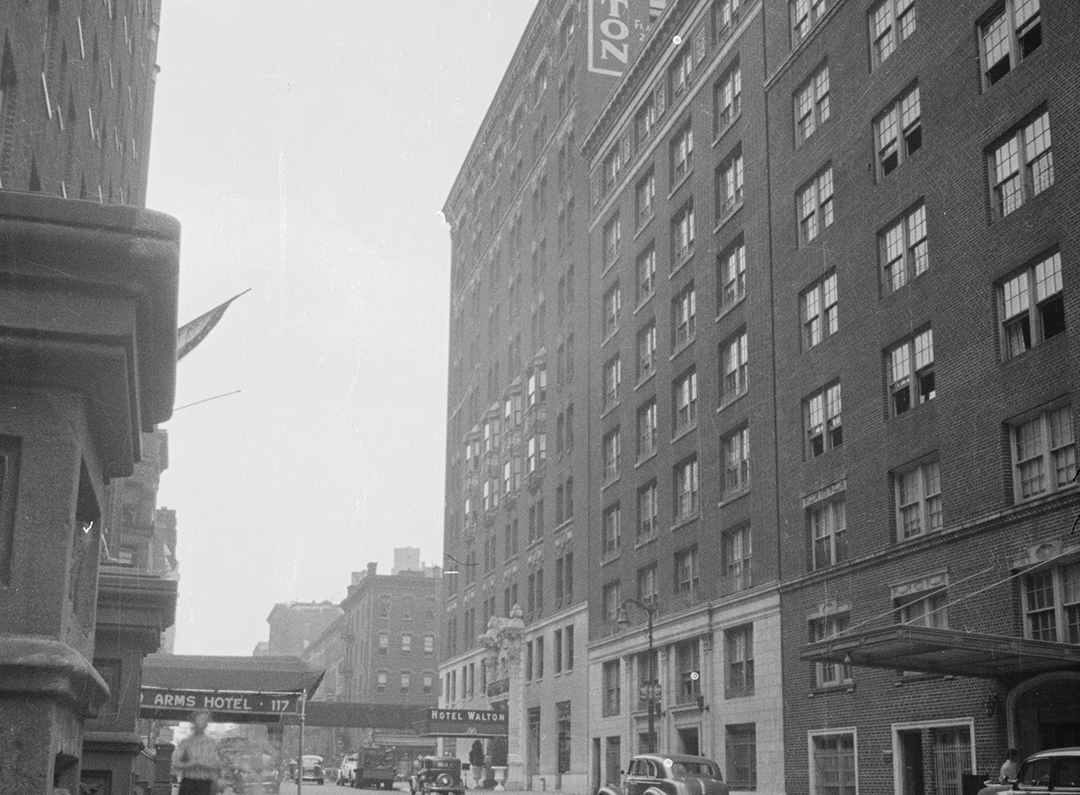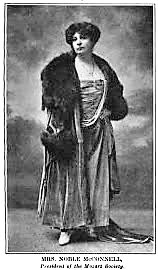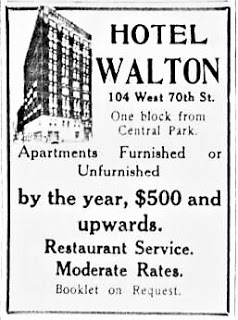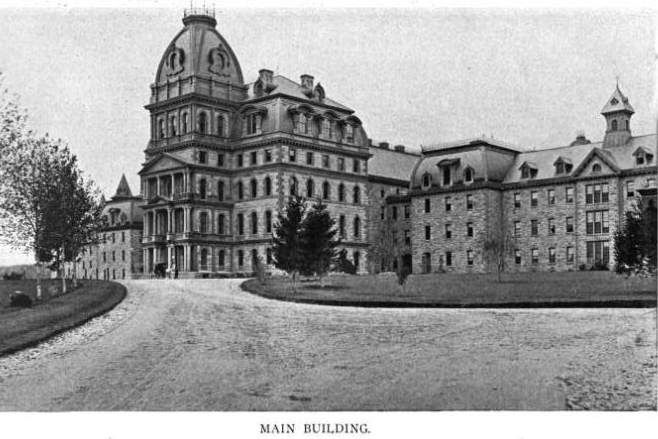
Global Affairs at the Hotel Walton
by Tom Miller, for They Were Here, Landmark West’s Cultural Immigrant Initiative
At the turn of the last century developer Elizabeth A. Wilcox held her own among her male counterparts. She was responsible for erecting large office buildings and hotels, most often working with builder Ranald H. Macdonald & Co.
In May 1903, the two teamed up for another project–the Hotel Walton on the southwest corner of Columbus Avenue and West 70th Street. Elizabeth’s architects, Israels & Harder, filed plans for a “12-story apartment hotel” to cost $600,000–a significant $17.2 million today.
Completed the following year, the architects’ toned down design was a bit of a surprise. At a time when other Beaux Arts-style residence hotels were overladen with a profusion swags and wreaths and other frothy decorations, the Hotel Walton was shockingly restrained. Its red brick facade above the two-story stone base included limited stone embellishments. Two-story copper clad projecting bays graced the fifth and sixth floors, adding interest and dimension.Nevertheless, Israels & Harder let loose Beaux Arts resplendence on the entrance (located on the side street). Carved bell flowers dripped from the banding of the double-height fluted Corinthian columns of the entrance. A French-railed balcony sat on scrolled brackets, and a feathery fan filled the semi-round pediment. Eleven stories above, the elaborate metal cornice sat on heavy brackets.
Ranald H. Macdonald defended the scaled back decoration in June 1908. He told a journalist from The Real Estate Record & Guide, “The exterior of the building is certainly plain, but I consider it in good taste. It is not so expensive as some in the city, but the result of giving people something worth while for their money has borne fruit. I believe there is a waiting list of about forty families desiring to rent suites there.”
Residence hotels like the Walton were designed to relieve well-to-do families of the necessity of maintaining a large domestic staff. Meals could be taken in a common dining room and the building management provided basic services like cleaning, “hall boys” (who delivered packages and handled small chores), and such. Families could make do with a single maid in most cases.
The tenants of the Hotel Walton were financially comfortable, if not wealthy. Among the early occupants was Althea Randolph Bedle, the widow of former New Jersey Governor Joseph D. Bedle. Her grown sons had both gone into the legal profession. Randolph had graduated from Princeton University and was a practicing lawyer, and Joseph was a former judge.
“The exterior of the building is certainly plain, but I consider it in good taste. It is not so expensive as some in the city, but the result of giving people something worth while for their money has borne fruit. I believe there is a waiting list of about forty families desiring to rent suites there.”
Althea suffered some public embarrassment in December 1910. A year earlier, she had been concerned that Randolph had a drinking problem. Therefore, on October 6, 1909 she and Joseph had him committed to the New Jersey State Asylum for the Insane in Morris Plains. Their belief was that “the close confinement there would assist in saving him from a too strong craving for alcoholic liquors.”
Randolph felt otherwise. He pleaded with friends to help in his release and told Robert O’Donnell, for instance, “Because I drank too much fourteen months ago is not a good reason for keeping me locked up with lunatics. During the first few days I was a prisoner here I was ill from the effects of the drinking I had done. As soon as I recovered I realized that unless I was released I was doomed to a living death of horrors.”
Randolph’s friends rallied to his cause and hired lawyer Alexander Simpson to fight for his release. Newspapers in several states carried the story as the case played out in court and the Bedles’ good name was loosely linked with insanity and alcoholism.
Pianist and writer Harriette Moore Brower lived in the Hotel Walton at the time. She wrote the column “Page for Pianists” in The Musician and contributed articles to Musical America. Eventually she would publish ten books, like The Art of the Pianist and Home Help in Music Study.
Nobel McConnell was a partner with his brother in the dry goods commission agency Edward A. McConnell & Co. But it was his wife, the former Adelaide Dorn, who drew attention. Adelaide held a physician’s degree; although she does not appear to have ever practiced nor used her title. Instead, she focused on philanthropy and music.
She was the founder and president of the New York Mozart Society, which staged concerts and musicales that often featured some of the most recognized soloists in the country. Possibly to maintain enthusiasm among the younger members she hosted a monthly dance during the winter seasons. On October 29, 1916, for instance, The Sun reported “Mrs. Noble McConnell will resume her monthly dance for the choral members, bachelor girls, junior cabinet and ushers of the New York Mozart Society, of which she is president, on the first Wednesday in December at Bretten Hall.”
The McConnell’s country residence was upstate and that particular winter season they kept it open. Although they were back in the Hotel Walton, The Sun noted “but [they] will keep their country home at Scarsdale open throughout the winter and will entertain week end parties there.”
Another colorful resident was Colonel N. B. Thurston of the 74th New York Regiment. Thurston had enlisted in the National Guard in 1877 and saw action in the Spanish-American War. He assumed command of the 13th Regiment of the Coast Artillery in June, 1914. In 1902, he had been appointed First Deputy Police Commissioner by Mayor Seth Low.
Rather surprisingly, given his age, he was sent to the Mexican border after President Woodrow Wilson ordered 117,000 National Guardsmen to reinforce U.S. Army garrisons along the border line in 1916. His wife received devastating news on September 9. Major George H. Robinson’s succinct telegram read “Thurston died tonight of dysentery. Every one broken-hearted.”
In 1910, Manuel Quevedo, Sr. was appointed Cuba’s vice-consul in New York City. He partnered eight years later with his son, Manuel Quevedo, Jr. and J. A. Arroyo to form the Havana Hotel Corporation. On June 22 that year, The Hotel World reported that the new group had taken over the lease of the Hotel Walton and purchased its furniture and equipment.
Little changed in the operation of the Hotel Walton under the Cuban organization. It did, however, become home to notable Cuban nationals who split their time between New York and their homeland. Among them was Gabriel Menocal, who owned sugar plantations and a cattle ranch. The brother of former Cuban President Mario Garcia Menocal, he was here with his wife, Marie, and five children in the winter of 1922. Four days after he contracted influenza on February 9, the 53-year old died in his apartment.
On June 30 that year 35-year old George Hill entered the dining room of the Hotel Walton with another man and two women. When their meal was nearly over, Hill called over the head waiter, Alexander Haggis, flashed a shield, and identified himself as a Prohibition agent. He pointed to the two drinks sitting on the table.
The waiter staunchly denied he had served the drinks, and later told Haggis he had seen Hill remove a flask from his pocket and pour the whisky himself. As Hill wrote out two summonses, the two waiters continued to protest their innocence. Then the agent “indicated that everything might be ‘fixed up’ for $200.”
Unwilling to be bullied into paying for a crime that was not committed, Haggis and the Hotel Walton management went to authorities. As it turned out, Hill was not a Government employee at all. He was arrested at his home on Amsterdam Avenue on the night of August 26, charged with extortion and impersonating a Federal agent. The following day The New York Herald reported “in about twenty cases [he] got money from waiters by similar threats.”
In 1928 Cuba President Geraldo Machado brought an end to the republic by declaring himself the only legal candidate, thereby ensuring his uncontested election. His dictatorial actions, including the assassination of revolutionary Julio Antonio Mella, led to a revolt in 1933.
Albert Barreras had been President of the Cuba Senate and was a close friend of the ousted dictator. He and his family left Havana for their safety. When his daughter, Sofia, and her husband Carlos Montalvo arrived in New York on August 24, 1933, they moved into the Hotel Walton, well-known among Cubans for decades.
But New York had a substantial community of anti-Machado Cubas, as well; and they quickly discovered where the Montalvos lived. On the night of September 8, Carlos was standing in the lobby with “two other refugees,” as described by The New York Times, when they were “set upon by a group of young Cubans.” There were six or seven in the angry group, but they were bested by the three hard-hitting refugees. The Times reported Montalvo and his friends “stood off the attacking party with their fists,” and that “after an exchange of fisticuffs the assailants fled.”
In 1928 Cuba President Geraldo Machado brought an end to the republic by declaring himself the only legal candidate, thereby ensuring his uncontested election. His dictatorial actions, including the assassination of revolutionary Julio Antonio Mella, led to a revolt in 1933.
Residents were understandably shaken and one called the police. The newspaper said “Senor Montalvo…ignored a police warning that he remain indoors until the unrest in Cuba subsides. When the excitement had died down he took up a post at the hotel’s entrance. Conspicuous in his linen suit, smoking a long, black cigar, he admitted he was waiting for his assailants’ return.”
He told a reporter “I took care of three of them myself. They are cowards. They cannot fight.”
The Hotel Walton played a minor part in world politics again in 1946 when one of the store spaces became the offices of the Political Action Committee for Palestine, Inc. Despite its unassuming headquarters, the group was significant. In June that year, it announced the appointment of a board of seven to investigate conditions in the prison camps of Palestine and the concentration camps of Eritrea, Africa. Concurrently it announced the appointment of eight new members of the executive board, including Governor Lester C. Hunt of Wyoming, Joseph E. Davis, former United States Ambassador to Russia, and Dr. Wallace W. Atwood, president of Clark University in Massachusetts.
In 1950, a renovation resulted in 13 apartments per floor. Among the residents in the now-smaller spaces in 1955 was Marie Monell. Although her second floor apartment contained just one bedroom; she still brought her 12 year old niece, Olga Cassanova, from the Virgin Islands to live with her.
The two managed for two years. In 1957, Olga was enrolled as an eighth grade student at the Blessed Sacrament Roman Catholic School on West 70th Street. But, on the night of May 20 that year, she and her aunt got into a serious argument. Olga stormed out of the apartment and, unknown to Marie, headed upstairs rather than to the street.
At about 9:15 someone noticed the 14-year old girl standing on the edge of the roof. Police arrived and pleaded with her not to jump as a growing crowd assembled on the street. The police worked with Olga for about 20 minutes. The Times reported, “Several hundred persons watched as the girl threatened to jump. She plunged from the ledge at 9:42 o’clock.” Olga died instantly.
In 1958, Cuba was once again on the brink of revolution. And once again the Hotel Walton played a small part. Despite its tradition of being a refuge of the Cuban establishment–or perhaps because of it–it was the scene of a press conference by Dr. Mario Lierena, chairman of the Committee in Exile of the 26th of July Movement, and Judge Manuel Urrutia, Fidel Castro’s choice for Provisional President to replace President Fulgencio Batista.
During the event, the men predicted, “that President Batista would fall from power by the end of the month,” according to The Times on April 4, 1958. “At the same time, the spokesman also declared that the 26th of July Movement, headed by Senor Castro, would reject any cooperation from Communists in Cuba.”
As the decades passed, the Hotel Walton settled into a much less political role and disappeared from the news. It was to most just another brick apartment building. In 1980, another renovation resulted in eight apartments per floor, and an added penthouse level that includes three apartments and half of a duplex, which extends to the 11th floor. Sadly, the cornice–all-important to the 1903 design–was removed, leaving a decidedly unfinished appearance.
Tom Miller is a social historian and blogger at daytoninmanhattan.blogspot.com
LEARN MORE ABOUT
210-216 Columbus Avenue
Keep
Exploring
Be a part of history!
Shop local to support the businesses currently at 210-216 Columbus Avenue:
Meet Madge Rosenberg!
Meet Sami Baker!
Meet Lara Kornbluh!






